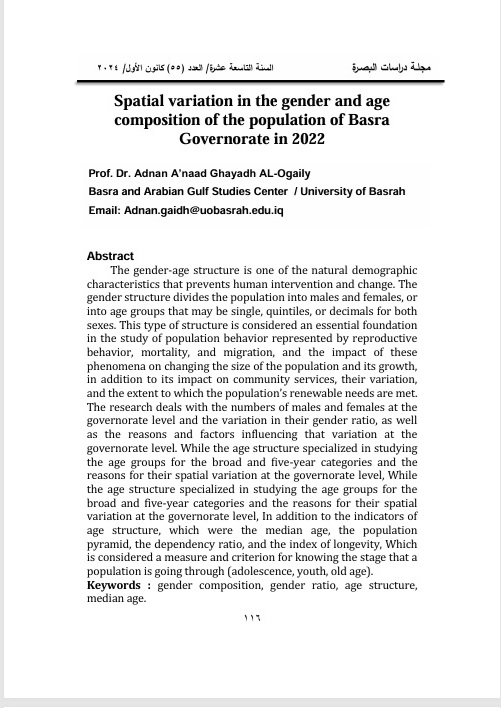Spatial variation in the gender and age composition of the population of Basra Governorate in 2022
Main Article Content
Abstract
The gender-age structure is one of the natural demographic characteristics that prevents human intervention and change. The gender structure divides the population into males and females, or into age groups that may be single, quintiles, or decimals for both sexes. This type of structure is considered an essential foundation in the study of population behavior represented by reproductive behavior, mortality, and migration, and the impact of these phenomena on changing the size of the population and its growth, in addition to its impact on community services, their variation, and the extent to which the population’s renewable needs are met. The research deals with the numbers of males and females at the governorate level and the variation in their gender ratio, as well as the reasons and factors influencing that variation at the governorate level. While the age structure specialized in studying the age groups for the broad and five-year categories and the reasons for their spatial variation at the governorate level, While the age structure specialized in studying the age groups for the broad and five-year categories and the reasons for their spatial variation at the governorate level, In addition to the indicators of age structure, which were the median age, the population pyramid, the dependency ratio, and the index of longevity, Which is considered a measure and criterion for knowing the stage that a population is going through (adolescence, youth, old age).
Article Details

This work is licensed under a Creative Commons Attribution-ShareAlike 4.0 International License.
References
المصادر
ـ أبو عيانة، محمد فتحي، جغرافية السكان أسس وتطبيقات، دار المعرفة الجامعية، الإسكندرية، 1999.
ـ إحصاءات البنك العالمي لسنة 2020.
ـ إسماعيل، احمد علي، أسس السكان وتطبيقاتهُ الجغرافية، دار الثقافة للنشر والتوزيع، القاهرة، 1997.
ـ الرشيدي، منير طلعت، السكان والتباين الجغرافي أسس التنمية المستدامة ودوافع الهجرة، دار الكتاب الحديثة، القاهرة، 2009.
ـ الزيادي، حسام صبار هادي، الأطلس الجغرافي الرقمي لسكان العراق تصميم وقراءة وتحليل باستخدام الجيوماتكس، أطروحة دكتوراه، كلية الآداب، جامعة البصرة، جدول (47).
ـ السرياني، محمد محمود، العمر الوسيط لسكان المملكة العربية السعودية حسب تعداد 1394ه (1974م)، مجلة الدارة، العدد الأول، السنة 15، دار الملك عبد العزيز، 1985.
ـ السعدي، عباس فاضل، جغرافية السكان، الجزء الثاني، دار الكتب للطباعة والنشر، بغداد، 2002.
ـ العثمان، باسم عبد العزيز عمر، العـﮔيلي عدنان عناد غياض، جغرافية السكان، أسس وتطبيقات، دار الوضاح للنشر، عمان، الأردن، 2020.
ـ عطوي، عبدالله، جغرافية السكان، منشورات دار النهضة العربية، بيروت، لبنان، 2001.
ـ وزارة التخطيط، الجهاز المركزي للإحصاء، مديرية إحصاء البصرة، بيانات غير منشورة.
Sources
-Abu Ayana, Muhammad Fathi, Population Geography, Foundations and Applications, University Knowledge House, Alexandria, 1999.
-Al-Othman, Bassem Abdul Aziz Omar, Al-Alayli Adnan Anad Ghayad, Population Geography, Foundations and Applications, Al-Wadah Publishing House, Amman, Jordan, 2020.
-Al-Rashidi, Mounir Talaat, Population and Geographic Variation, Foundations of Sustainable Development and Motives for Migration, Modern Dar Al-Kitab, Cairo, 2009.
-Al-Saadi, Abbas Fadel, Population Geography, Part Two, Dar Al-Kutub for Printing and Publishing, Baghdad, 2002.
-Al-Saryani, Muhammad Mahmoud, The median age of the population of the Kingdom of Saudi Arabia according to the census of 1394 AH (1974 AD), Al-Dara magazine, first issue, year 15, King Abdulaziz Publishing House, 1985.
-Al-Zayadi, Hossam Sabbar Hadi, The Digital Geographic Atlas of the Population of Iraq, Design, Reading, and Analysis Using Geomatics, PhD thesis, College of Arts, University of Basra, Table (47).
-Atwi, Abdullah, Population Geography, Dar Al-Nahda Al-Arabiya Publications, Beirut, Lebanon, 2001.
-Ismail, Ahmed Ali, The foundations of population and its geographical applications, Dar Al-Thaqafa for Publishing and Distribution, Cairo, 1997.
-Ministry of Planning, Central Bureau of Statistics, Basra Statistics Directorate, unpublished data.
-World Bank statistics for 2020.
